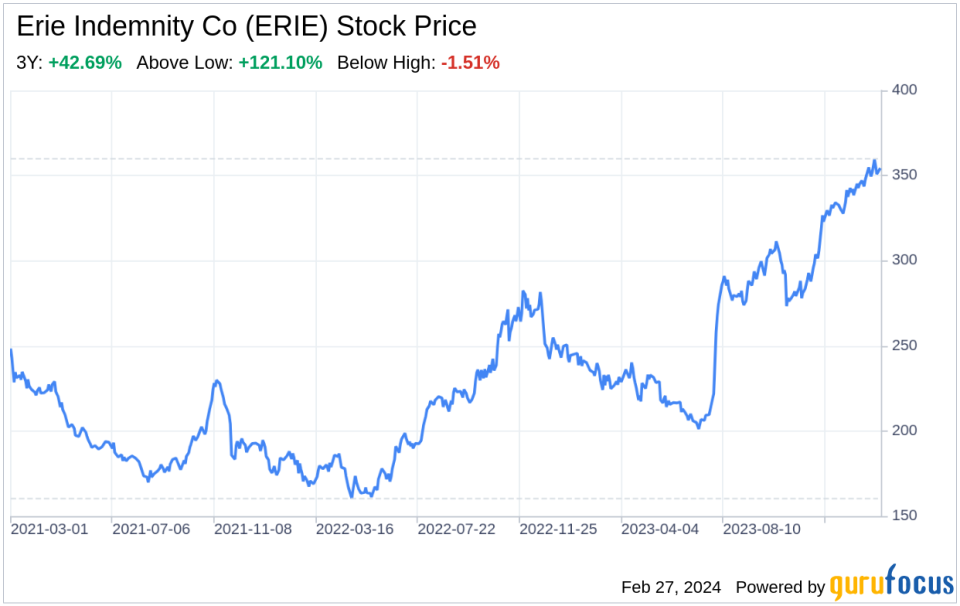Decoding Erie Indemnity Co (ERIE): A Strategic SWOT Insight
Strengths highlight Erie Indemnity Co's robust service model and strong brand reputation.
Weaknesses underscore the company's reliance on the Erie Insurance Exchange and associated risks.
Opportunities emphasize potential market expansion and technological advancements.
Threats focus on competitive pressures and legal challenges impacting the company.
On February 26, 2024, Erie Indemnity Co (NASDAQ:ERIE) filed its annual 10-K report, providing a comprehensive overview of its financial performance and strategic positioning. As a company that primarily performs services on behalf of the Erie Insurance Exchange, ERIE's financial health is closely tied to the Exchange's performance. The company's management fee, which is typically 25% of the Exchange's premiums, constitutes its entire revenue stream. With a market capitalization of $5.3 billion as of June 30, 2023, and a solid track record of policy issuance, underwriting, and claims handling, ERIE presents a unique profile in the insurance services industry.

Strengths
Robust Service Model and Brand Reputation: Erie Indemnity Co's strength lies in its established service model and brand reputation. As the attorney-in-fact for the Erie Insurance Exchange, ERIE has built a legacy of trust and efficiency in policy issuance and renewal services. The company's brand is synonymous with quality customer service, which is a significant differentiator in the competitive insurance market. This reputation is supported by a disciplined underwriting philosophy and a strategic focus on generating higher risk-adjusted investment returns, positioning ERIE to provide excellent service at the lowest possible cost.
Financial Stability and Capital Position: ERIE's financial stability is another key strength. The company's management fee revenue model, based on a percentage of the Exchange's premiums, ensures a steady income stream. This model, coupled with a strong surplus position, allows ERIE to maintain a robust capital structure, which is critical for sustaining operations and investing in growth initiatives. Furthermore, the company's ability to retain a significant portion of its workforce, as indicated by lower-than-industry-average turnover rates, contributes to its operational stability and expertise retention.
Weaknesses
Dependence on Erie Insurance Exchange: A primary weakness for Erie Indemnity Co is its reliance on the Erie Insurance Exchange for all its revenue. This dependence places ERIE at risk of financial volatility should the Exchange face challenges in growth, financial condition, or experience significant catastrophe losses. The company's financial performance is directly impacted by the Exchange's ability to retain and attract new business, making it susceptible to fluctuations in the Exchange's premium volumes.
Concentration of Credit Risk: ERIE's financial statements reveal a concentration of credit risk related to unsecured receivables due from the Exchange. This exposure to a single receivable source increases the company's vulnerability to the Exchange's creditworthiness. While ERIE has a history of successful operations, this concentration of credit risk could pose a significant threat if the Exchange's financial condition were to deteriorate.
Opportunities
Market Expansion and Product Innovation: Erie Indemnity Co has the opportunity to expand its market share by leveraging its strong brand and customer service reputation. By innovating and diversifying its product offerings, ERIE can meet evolving customer demands and tap into new customer segments. The company's focus on disciplined underwriting and superior investment returns positions it well to capitalize on market opportunities and drive growth.
Technological Advancements: The adoption of advanced technologies presents an opportunity for ERIE to enhance its operational efficiency and customer engagement. By investing in digital platforms, data analytics, and automation, the company can streamline processes, improve risk assessment, and offer personalized services. This technological edge could lead to improved customer satisfaction and loyalty, further strengthening ERIE's competitive position.
Threats
Competitive Pressures: The insurance industry is highly competitive, with companies vying for market share based on price, coverage options, and customer service. ERIE faces intense competition from national and regional insurers, as well as from direct-to-consumer sales models. To maintain its market position, ERIE must continuously innovate and adapt to changing consumer preferences and competitive strategies.
Legal and Regulatory Challenges: Erie Indemnity Co is subject to legal proceedings and regulatory scrutiny, as evidenced by the ongoing litigation regarding the management fee setting. Such legal challenges can result in financial liabilities, reputational damage, and operational disruptions. Additionally, the insurance industry's regulatory environment is complex and evolving, requiring ERIE to stay compliant with new regulations, which could impose additional costs and constraints on the company.
In conclusion, Erie Indemnity Co (NASDAQ:ERIE) exhibits a strong service model and financial stability, which are foundational to its success. However, the company's reliance on the Erie Insurance Exchange and the associated risks underscore the need for strategic risk management and diversification. Opportunities for market expansion and technological advancements offer pathways for growth, while competitive pressures and legal challenges necessitate vigilance and adaptability. As ERIE navigates its strategic landscape, it must leverage its strengths, address its weaknesses, seize opportunities, and mitigate threats to sustain its competitive edge and continue delivering value to its stakeholders.
This article, generated by GuruFocus, is designed to provide general insights and is not tailored financial advice. Our commentary is rooted in historical data and analyst projections, utilizing an impartial methodology, and is not intended to serve as specific investment guidance. It does not formulate a recommendation to purchase or divest any stock and does not consider individual investment objectives or financial circumstances. Our objective is to deliver long-term, fundamental data-driven analysis. Be aware that our analysis might not incorporate the most recent, price-sensitive company announcements or qualitative information. GuruFocus holds no position in the stocks mentioned herein.
This article first appeared on GuruFocus.
